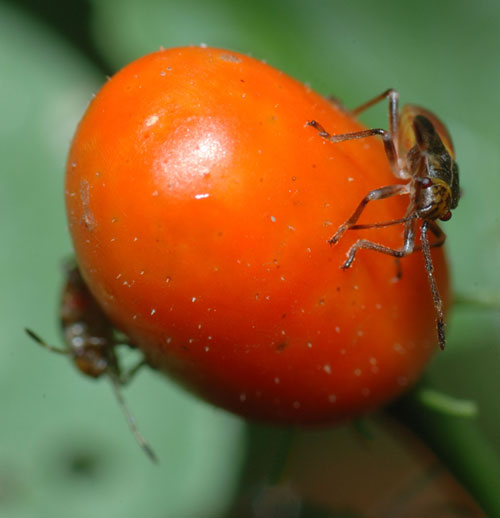Self-Defense: Why Chili Peppers Pack Heat

The spicy heat that sears your taste buds when you bite into tacos slathered with hot salsa is actually a defense mechanism that some chili peppers use against fungi, a new study finds. And this anti-fungal chemistry also could be why chilies were among the earliest domesticated crops in the New World as they were probably found by early Native Americans to be a safe food in a world full of unknown dangers. "Before there was refrigeration, it was probably adaptive to eat chilies, particularly in the tropics. Back then, if you lived in a warm and humid climate, eating could be downright dangerous because virtually everything was packed with microbes, many of them harmful," said study leader Joshua Tewksbury of the University of Washington. "People probably added chilies to their stews because spicy stews were less likely to kill them." A pungent solution Chilies, like other fruits, use sugars and lipids to attract birds and other hungry animals that will eat them and eventually scatter their seeds in the process. But fungi and plant-feeding insects, which puncture chilies' outer skin and allow the fungi to invade, can also try to get in on the meal. Working together, they can destroy a fruit's seeds before it gets a chance to reproduce. "For these wild chilies the biggest danger to the seed comes before dispersal, when a large number are killed by this fungus," Tewksbury said. "Both the fungus and the birds eat chilies, but the fungus never disperses seeds — it just kills them." Chilies have evolved a pungent solution to this problem: They produce chemicals called capsaicinoids that protect them from fungal attack by dramatically slowing microbial growth. The capsaicinoids also produce the tear-inducing heat associated with the spicy fruit, though this doesn't bother hungry birds. "Capsaicin doesn't stop the dispersal of seeds because birds don't sense the pain and so they continue to eat peppers, but the fungus that kills pepper seeds is quite sensitive to this chemical," Tewksbury said. He added that the chilies' spicy defense mechanism is "a great example of the power of natural selection." Fungal killers To study the mechanism, Tewksbury and his colleagues collected chilies of the same species spread across 1,000 square miles in Bolivia. They randomly selected peppers and counted the scars on the outer skin that are signs of insect foraging. Their research showed that there were more of the spicy-hot plants in areas with larger pepper-eating insect populations. Plants that lived in areas where fungal attacks were common also produced higher levels of capsaicinoids. But plants that lived in less dangerous areas were as mild as a bell pepper, the researchers found. Other fruits, such as tomatoes, also pump themselves full of substances to ward off attacks while their seeds mature. But unlike peppers, most other fruits lose these chemical defenses when they ripen, exposing them eventually to fungal attacks. "By contrast, peppers increase their chemical defense levels, or heat, as they ripen," Tewksbury said. Chilies can get away with this because the main dispersers of their seeds, birds, are immune to the spiciness. The study, funded by the National Science Foundation and National Geographic Society, is detailed in the online version of the Aug. 11 issue of the journal Proceedings of the National Academy of Sciences. Chili origins All chilies originated in South America, and wild chilies now grow from central South America to the southwestern United States. Explorers carried the plants back to Europe, but they were not widely used there. From Europe, chilies made their way to Asia and Africa, where they have become a common ingredient in nearly every tropical cuisine. "In the north, any adaptive benefit to using eating chilies would be much smaller than at the equator because microbial infection of food is less common and it's easier to keep food cold. Maybe that's why food in the north can be so boring," Tewksbury said. "Along the equator, without access to refrigeration, you could be dead pretty quickly unless you can find a way to protect yourself against the microbes you ingest every day." While the capsaicinoids in wild chilies will kill off many kinds of microbes, the domesticated chilies we eat today, such as jalapeños, don't pack quite the punch of their wild cousins. Tewksbury explained that in the process of domestication, we bred chilies to be bigger and milder. "Jalapeños are not hot chilies," he said. And wild chilies are much smaller, about the size of the nail on your pinky finger, meaning "they're nothing but seeds and skin," as Tewksbury put it, so any microbe that tries to latch on comes into contact with the capsaicinoids very quickly. But in a jalapeño, microbes could sit on the tip of the fruit, away from the seeds, and take hold without every encountering the spicy killer chemicals. This could be one reason why salmonella were able to contaminate Mexican jalapeños earlier this summer, Tewksbury told LiveScience.
- Top 10 Poisonous Plants
- Surprising Truths About Fruits and Vegetables
- Why do Chili Peppers Taste Hot?
Sign up for the Live Science daily newsletter now
Get the world’s most fascinating discoveries delivered straight to your inbox.

Andrea Thompson is an associate editor at Scientific American, where she covers sustainability, energy and the environment. Prior to that, she was a senior writer covering climate science at Climate Central and a reporter and editor at Live Science, where she primarily covered Earth science and the environment. She holds a graduate degree in science health and environmental reporting from New York University, as well as a bachelor of science and and masters of science in atmospheric chemistry from the Georgia Institute of Technology.









